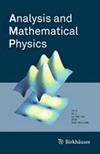低正则双曲系统的模式解耦
IF 1.4
3区 数学
Q1 MATHEMATICS
引用次数: 0
摘要
我们证明了二阶双曲系统不同模态之间的耦合算子是阶一平滑的,我们假设符号的特征值是常阶的,并且系统的系数具有有界的二阶导数。一个重要的例子是线性各向同性弹性的波方程,我们假设拉梅参数和质量密度具有有界的二阶导数。这扩展了 Brytik 等人建立的弹性波方程的结果。本文章由计算机程序翻译,如有差异,请以英文原文为准。
Decoupling of modes for low regularity hyperbolic systems
We show that the coupling operator between distinct modes of a second-order hyperbolic system is smoothing of degree one, where we assume that the eigenvalues of the symbol are of constant rank, and that the coefficients of the system have bounded derivatives of second order. An important example is the wave equation for linear isotropic elasticity, where our assumption states that the Lamé parameters and mass density have bounded derivatives of second order. This extends a result for the elastic wave equation established by Brytik, et.al.
求助全文
通过发布文献求助,成功后即可免费获取论文全文。
去求助
来源期刊

Analysis and Mathematical Physics
MATHEMATICS, APPLIED-MATHEMATICS
CiteScore
2.70
自引率
0.00%
发文量
122
期刊介绍:
Analysis and Mathematical Physics (AMP) publishes current research results as well as selected high-quality survey articles in real, complex, harmonic; and geometric analysis originating and or having applications in mathematical physics. The journal promotes dialog among specialists in these areas.
 求助内容:
求助内容: 应助结果提醒方式:
应助结果提醒方式:


